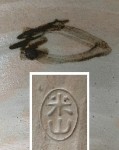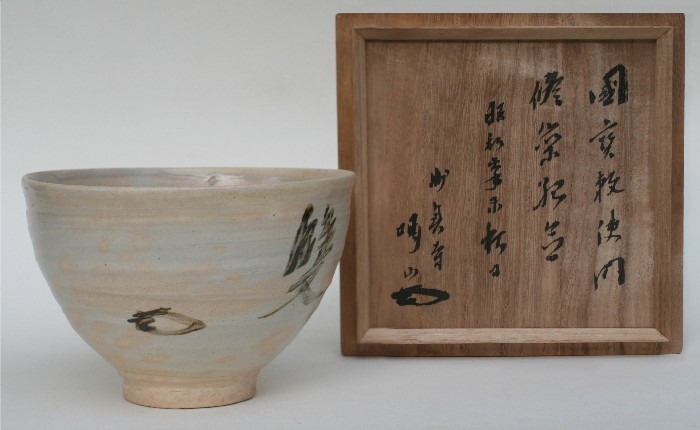Karatsuyaki / Zenga
Chawan, teacup - MusôSigned: Kaô
Seals: Beizan
Technique: Karatsuyaki - Wheel turned earthenware with Setô style gohonde slip Ø 13,2 x 8,6
Date: 1931 autumn
Box: signed
Condition: fine
In memory of the renovation of the capital and the rebuilding of the [national treasure] Chokukuchi-gate on a day in autumn 1932.
Matsuoka Kankei (Kassan-kutsu) was born in Aichi Prefecture. He became a monk at the age of eleven. During his career he served as head of several Rinzai Zen temples: the Myoko-ji in Ichinomiya, the Shôfuku-ji in Fukuoka and the Jiun-ji in Aichi. Kankei practiced Zen under Gasan Shôtei (1853-1900) in the Tenryu-ji and with Tôgaku Shôshun (1841-1909) in the Shokoku-ji. He received his Dharma transmission from Kasan Genku (1837-1917).
He became the abbot of the Myoko-ji and built the Myoko Zenrin School. In 1919 he was invited to be the president of Rinzai University (present-day Hanazono University) where he stayed for 2 years. In 1932 he became abbot of the Shôfuku-ji in Fukuoka, home temple of the great Zen painter and calligrapher Sengai Gibon (ca. 1750-1837). In 1933 Kankei also became the Zen master of the Daitoku-ji. Although a member of the Myoshin-ji Zen establishment, Kankei was recommended to be the 495th chief abbot of the Daitoku-ji in 1932, but he succumbed to illness before he could assume that post. Kankei was a good calligrapher, but works by him are rather rare.
Reference:
Moog p. 229
Price: SOLD

